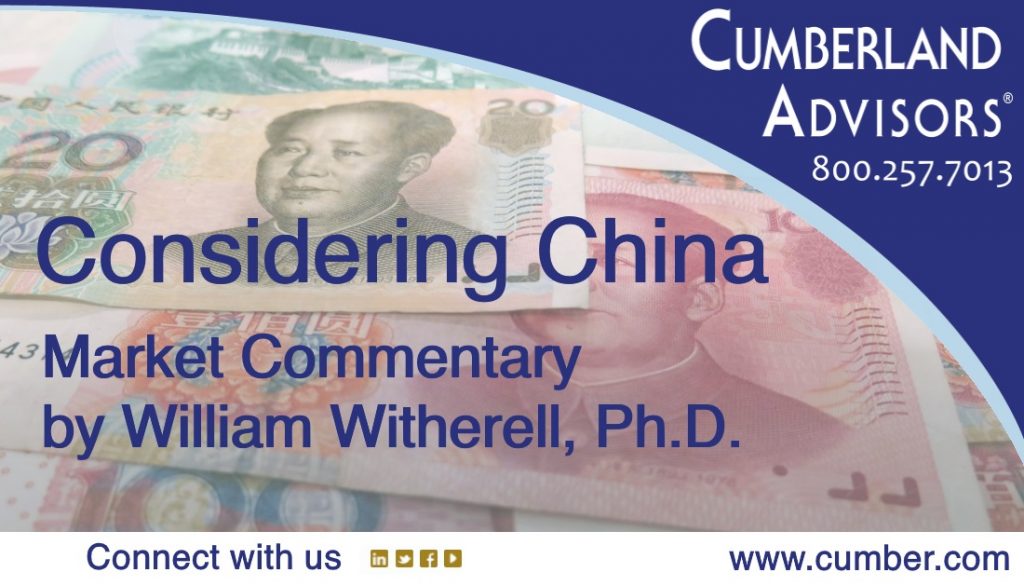China stocks surged Monday following Trump’s announcement that he will be delaying US tariffs on China. Prospects for a trade agreement between China and the US are now looking very good. It is evident that both sides need a positive resolution and are willing to compromise. Last year, China’s stock markets experienced their worst year since 2008, with the Shanghai composite dropping 24.6% and the Shenzhen composite tumbling over 33%. These markets appeared to bottom at year end and staged a strong recovery as trade tensions began to ease. This recovery is likely to continue if indeed a trade deal is reached.
The other main cause of last year’s plunge in China’s stock market was increasing signs of a slowdown in China’s economy, paired with uncertainty about the severity of the downshift. It has now become clearer that the slowdown is real but moderate, in contrast to the more dire predictions of some commentators. GDP growth is easing from 6.6% last year to 6.2% this year. In 2020, the economy is projected to expand at a similar and still very robust pace, thanks in part to the anticipated ample policy stimulus and easing of trade tensions.
As Morgan Stanley has noted, China is steadily advancing towards high-income status and a current account deficit that implies the necessity of substantially higher capital inflows. That prospect should encourage further opening up of the economy. Another technical factor that will cause passive investment inflows is MSCI’s plans to increase China A-shares weights in its EM index this year and more in future years. Similarly, FTSE Russell plans to increase the weight of China A-shares in its FTSE Emerging Index.
Changes in the structure of the Chinese economy provide some promising opportunities for investors. The economic slowdown has been mainly in the manufacturing sector, which used to be considered the most important part of the Chinese economy. According to Caixin Purchasing Managers Index data reported by Markit, while manufacturing companies’ output declined modestly in January, service-sector activity continued to expand “solidly,” with the result that the Caixin China Composite PMI for January signaled higher activity for the thirty-fifth month in a row.
It is important to note that China’s services sector became a more important contributor to GDP than its industrial sector in 2013. It has steadily outgrown the industrial sector ever since. The fact that China has already changed into a services/domestic consumption-based economy is not widely recognized.
The Chinese consumer is breaking records. Total Chinese retail sales, which surpassed US retail sales for the first time in 2017, rose a further 9% in 2018 to about US$6.3 trillion. According to 2017 figures cited by KraneShares, Chinese web sales, at US$1.14 trillion, accounted for 19.6% of total Chinese retail sales, whereas US retail web sales, at US$453.5 billion, accounted for just 8.9% of US retail sales. And there is still substantial room for China’s internet population, which is currently less than 60 % of the total population, to grow.
Investors now have 46 US-listed ETFs for Chinese stocks, excluding those ETFs using leverage. Many of these still have limited assets under management (AUM), which implies limited liquidity. There are just 10 that have AUM of at least US$100 million: FXI, MCHI, KWEB, GXC, ASHR, CQQQ, KBA, PGJ, CHIQ, and CXSE.
The largest China ETF, the iShares Large-Cap, FXI, invests in 50 large-cap China stocks traded in Hong Kong, with a heavy concentration of financials, particularly state-run banks. It is up 15.20% year-to-date February 25. The second and fourth largest Chinese ETFs invest in the “total market” (not including A-shares) with a tilt towards financial and technical firms. The iShares MSCI China ETF, MCHI, has gained 17.92% year-to-date. Similarly, the SPDR S&P China ETF, GXC, is up 17.56%.
The third largest China ETF takes a more direct aim at the Chinese consumer and internet web sales. KraneShares CSI China Internet ETF, KWEB, has gained 26.19% year-to-date. This ETF tracks only overseas-listed Chinese shares of internet-sector companies, primarily US-listed N-shares. Also of possible interest is the Investco China Technology ETF, CQQQ, which holds a broad range of technology companies, including US-listed shares. CQQQ has also outperformed this year, gaining 24.31% year-to-date.
William Witherell, Ph.D.
Chief Global Economist & Portfolio Manager
Email | Bio
Sources: Morgan Stanley Research, KraneShares, Caixin, HIS Markit, CNBC, ETF.com, IMF
Links to other websites or electronic media controlled or offered by Third-Parties (non-affiliates of Cumberland Advisors) are provided only as a reference and courtesy to our users. Cumberland Advisors has no control over such websites, does not recommend or endorse any opinions, ideas, products, information, or content of such sites, and makes no warranties as to the accuracy, completeness, reliability or suitability of their content. Cumberland Advisors hereby disclaims liability for any information, materials, products or services posted or offered at any of the Third-Party websites. The Third-Party may have a privacy and/or security policy different from that of Cumberland Advisors. Therefore, please refer to the specific privacy and security policies of the Third-Party when accessing their websites.
Sign up for our FREE Cumberland Market Commentaries
Cumberland Advisors Market Commentaries offer insights and analysis on upcoming, important economic issues that potentially impact global financial markets. Our team shares their thinking on global economic developments, market news and other factors that often influence investment opportunities and strategies.


